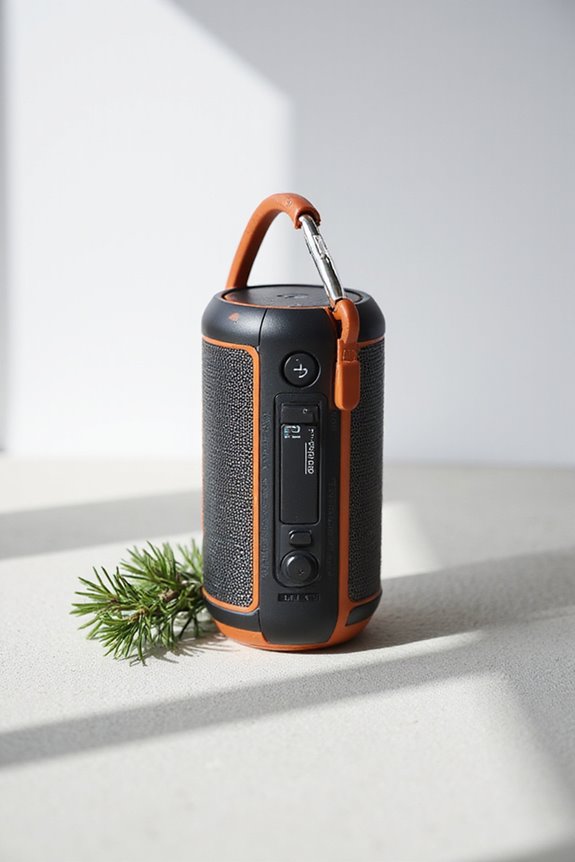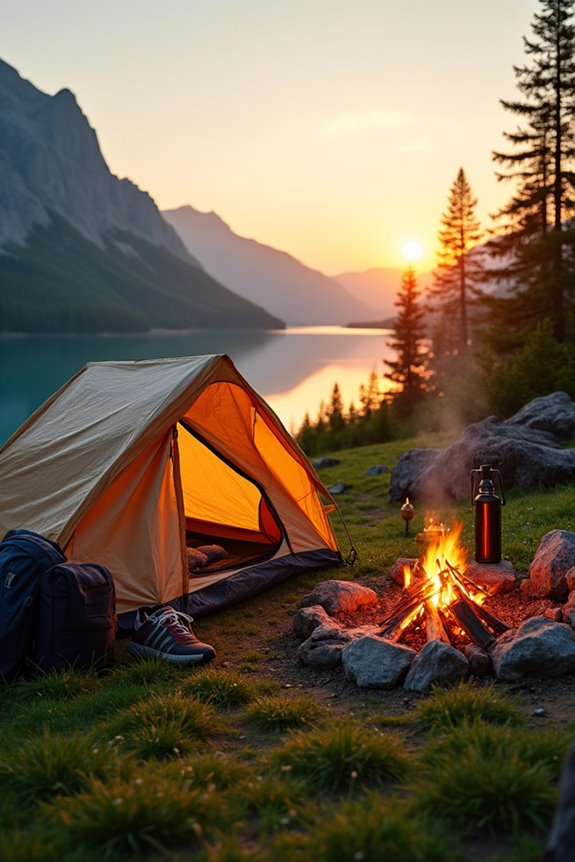When packing for a day hike, think essential clothing, sturdy hiking boots, and moisture-wicking socks to keep feet comfy and dry. Don’t forget about hydration—carry at least half a liter of water per hour! Snacks like trail mix and energy bars, a detailed topographic map, and a solid first aid kit are all must-haves. And hey, consider sun protection too! With a little prep, your adventure can be a blast. Discover more handy tips to elevate your hike!
Key Takeaways
- Pack sturdy hiking boots or trail runners, along with moisture-wicking socks for comfort and support on the trails.
- Carry at least 0.5 liters of water per hour to stay hydrated; consider purification systems for uncertain water sources.
- Bring a variety of snacks, such as trail mix and energy bars, aiming for around 1,500 calories for a typical five-hour hike.
- Equip yourself with a topographic map and a compass for navigation; ensure you can track time and distance with a reliable watch.
- Include a well-stocked first aid kit with adhesive bandages, antiseptic wipes, pain relievers, and any personal medications you may need.
Essential Clothing and Footwear
When gearing up for a day hike, the right clothing and footwear can make all the difference between a blissful trek and a miserable slog through the wilderness. Choosing the right footwear types is essential. Hiking boots offer sturdy support for rugged trails, while trail runners are perfect for lighter paths. Don’t forget those moisture-wicking socks to keep your feet dry and blister-free! As for clothing layers, start with a moisture-wicking base layer to stay comfortable. Quick-drying pants or shorts are versatile, adapting to changing weather. Top it off with a breathable shirt for airflow. Layering is key—don’t be caught shivering in a chilly breeze or drenched in unexpected rain. With the right gear, every step can be a joy! Additionally, consider waterproof and windproof capabilities to protect against unexpected weather changes.
Hydration Requirements
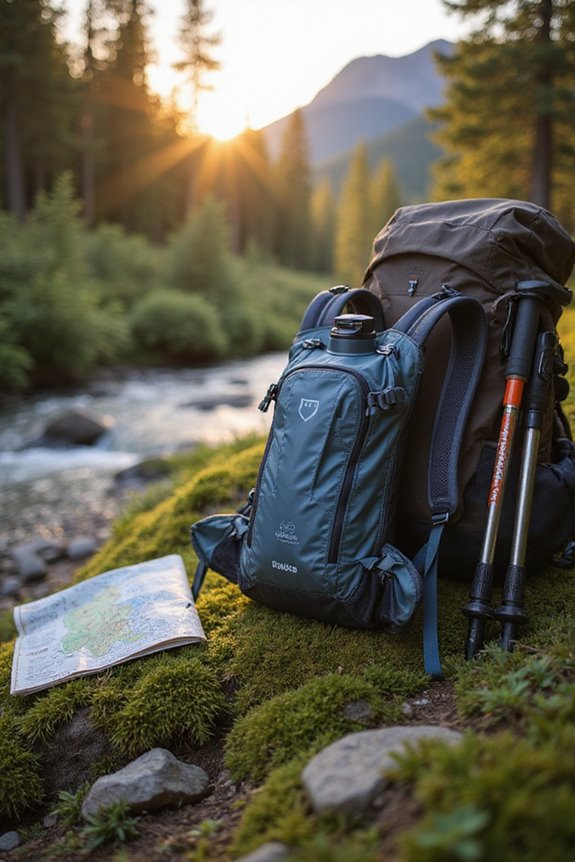
While hiking through breathtaking landscapes, it’s important to forget one crucial element: hydration. To keep energy levels high and enjoy the journey, hikers should adopt smart hydration strategies. A general rule is to drink about 0.5 liters (17 oz) of water per hour during moderate hikes, but this increases in hot, humid, or strenuous conditions. Don’t underestimate steep trails or high altitudes either, as they can zap fluid faster than you think! It’s important to carry enough water and consider water purification systems if you’ll be near unreliable sources. Remember, ignoring thirst can lead to dehydration. So, keep an eye on those early signs—thirst, dry mouth, and dark urine—and drink up for a safe, enjoyable adventure!
Nutrition and Snacks
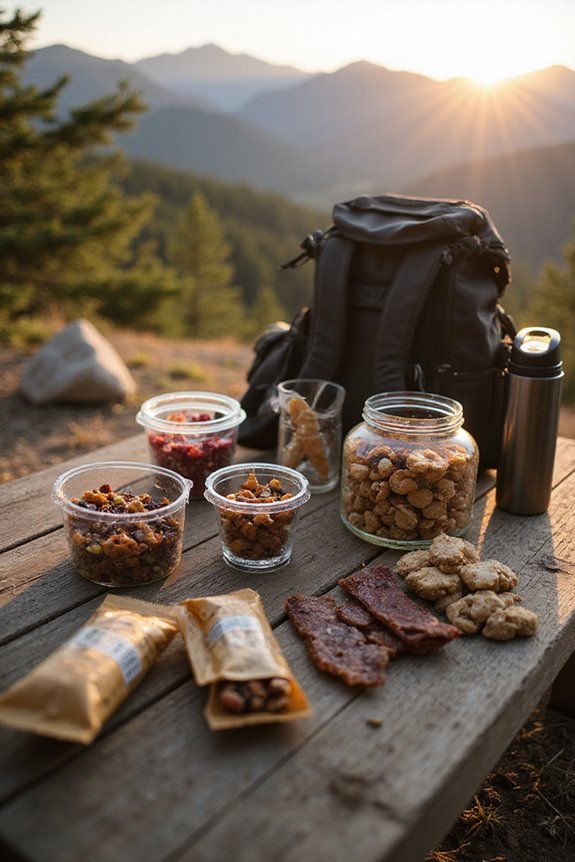
Packing the right snacks for a day hike can make all the difference between a fun adventure and a grueling slog. Aiming for a snack variety helps keep energy levels high and boredom at bay. Think trail mix, energy bars, and nut butter packets—delicious and easy to munch on the go! Portion control is key; divide snacks into single servings to avoid overindulging and to manage waste. Ideally, hikers should pack around 1,500 calories for a typical five-hour journey, snacking every 2–3 hours. Remember, a balanced meal before hitting the trail, along with the right mix of carbs, protein, and fats in those snacks, will fuel an enjoyable experience. So, pack wisely, and have fun out there!
Navigation Tools
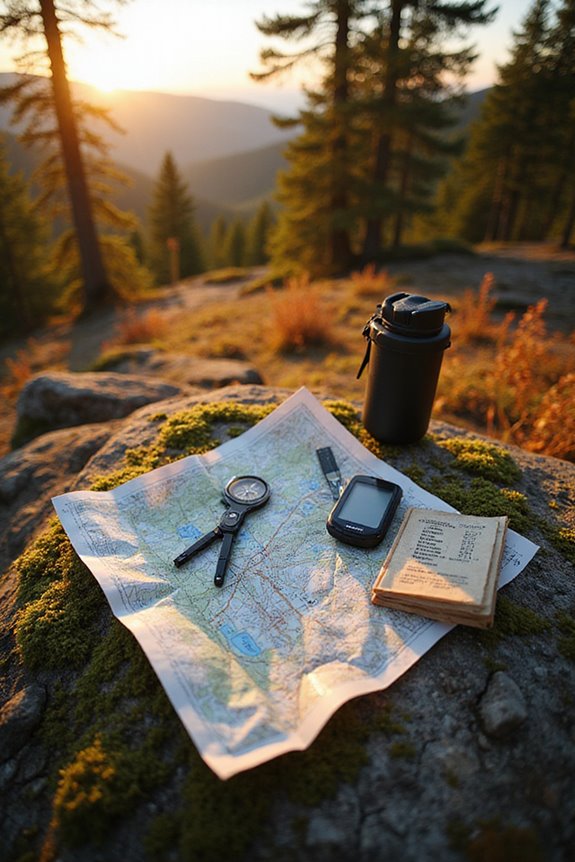
After fueling up with the right snacks, the next step in ensuring a successful day hike is traversing the great outdoors. Maneuvering through nature can be a thrilling adventure, and having the right navigation tools is key. A detailed topographic map is essential for map orientation, showing terrain and landmarks to help hikers stay on track. Mastering compass skills is equally important; it can guide you when GPS signals flicker out. For extra confidence, a reliable watch can assist in tracking time and distance, while an altimeter can reveal your elevation changes. Whether opting for a rugged GPS device or a trusty compass, being prepared will keep your hiking experience enjoyable—because getting lost isn’t nearly as fun as finding your way!
Safety and First Aid Supplies
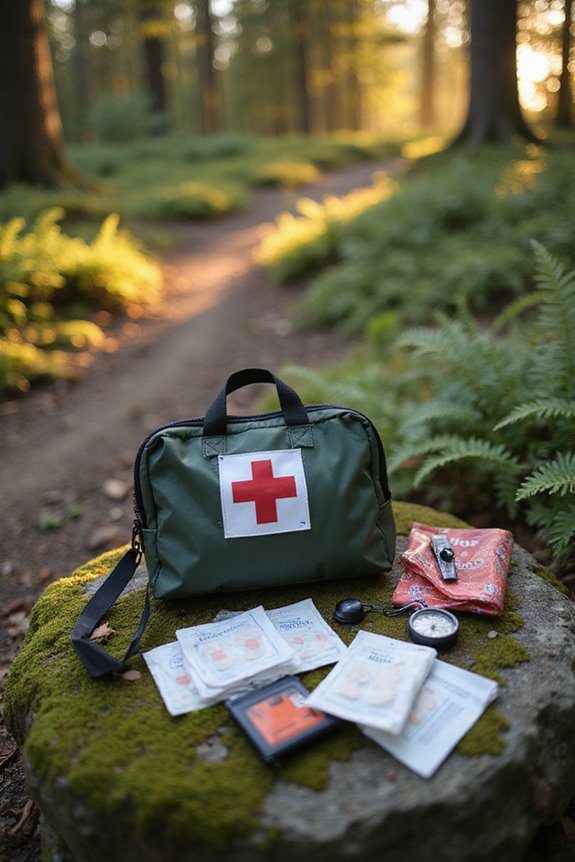
When heading out into the wild, it’s easy to get caught up in the excitement of the adventure, but safety should always be at the forefront of every hiker’s mind. Packing a well-thought-out first aid kit can make all the difference. Essential items include adhesive bandages for minor cuts, antiseptic wipes for disinfecting, and hydrocortisone cream for those pesky insect bites. Don’t forget over-the-counter pain relievers, like ibuprofen, and antihistamines for unexpected allergies! A pair of tweezers can be a lifesaver for removing splinters or ticks. Finally, consider customizing your kit for specific needs, like epinephrine for severe allergies. With proper emergency preparedness, hikers can focus more on the beautiful scenery and less on potential mishaps.
Sun and Insect Protection
Hikers often find themselves lost in the beauty of nature, but that radiant sun and pesky insects can quickly turn a delightful adventure into a frustrating ordeal. To stay protected, packing sun protection is essential. Long-sleeve shirts with UPF ratings, wide-brimmed hats, and portable sunscreen can be lifesavers. Don’t forget to apply that sunscreen generously, especially on your lips with a solid SPF 25+ balm! Insect repellents are equally important; those containing DEET or picaridin work wonders against biting critters. Wearing long sleeves and pants treated with permethrin helps keep those pesky bugs at bay. And if you’re in a buggy area, consider carrying insect netting for extra defense. After all, the only thing that should bite is the trail!
Weather Preparedness
Weather preparedness is the unsung hero of any successful day hike, often overlooked yet essential for a memorable adventure. When venturing outdoors, packing the right weather gear can make all the difference. Imagine hiking up a mountain, the sun shining, only for dark clouds to roll in unexpectedly. Having moisture-wicking base layers and a lightweight, breathable rain jacket ready for those sudden downpours can keep spirits high and bodies dry. Layering for temperature management is key, too; a cozy fleece jacket can be your best friend when chilly winds sweep through. And don’t forget those waterproof boots—nothing ruins fun faster than soggy socks! With a little planning, hikers can stay comfortable and focused on the beauty around them. Additionally, consider incorporating waterproof features into your gear choices to effectively block moisture and wind.
Personal Items and Extras
After braving the unpredictable whims of the weather, the next step in packing for a day hike involves gathering personal items and extras that can either make or break the experience. A trusty multitool is essential, perfect for everything from minor repairs to whipping up a snack. Don’t forget personal identification, cash, and any necessary park permits—imagine not being able to access that breathtaking view because you neglected these! Throw in a compact first aid kit just in case, and some insect repellent to keep those pesky bugs at bay. A camera or notebook can capture memories, while a little cash might score that post-hike ice cream. These thoughtful additions can transform a good hike into an unforgettable adventure!
Packing Tips and Organization
Packing for a day hike can feel like a puzzle, and getting it right makes all the difference between an enjoyable trek and a stressful scramble. Employing smart packing techniques is key. Start with a dedicated daypack sized 10-20 liters, the perfect balance for carrying essentials without the bulk. Organize your gear by category—clothing, food, navigation, and safety gear—using stuff sacks or zippered pouches to keep everything tidy. For stability, pack heavier items close to your back, while lighter gear goes in the outer pockets. Don’t forget your hydration system; a bladder with a bite valve keeps you sipping without stopping. And always stash your first-aid kit and navigation tools in easily reachable spots for peace of mind on the trail.
Frequently Asked Questions
How Do I Choose the Right Hiking Trail for My Skill Level?
Choosing the right hiking trail involves evaluating trail difficulty ratings and matching them with personal fitness levels. Beginners should select easier trails, while experienced hikers may pursue more challenging routes, ensuring safety and enjoyment.
What Should I Do if I Encounter Wildlife on the Trail?
When encountering wildlife, one should prioritize wildlife safety. Key encounter tips include maintaining distance, avoiding feeding, staying calm, and using deterrents if necessary while evaluating the situation and backing away slowly to guarantee safety.
How Can I Stay Motivated During a Long Hike?
While fatigue looms, hiking buddies uplift spirits through shared laughter; mental techniques, like positive affirmations and visualization, transform discomfort into motivation, forging a path of resilience and enjoyment amid the challenges of a long hike.
What Are the Signs of Dehydration While Hiking?
Dehydration symptoms during hiking include headaches, dizziness, and fatigue. To prevent these issues, hikers should follow hydration tips such as drinking water regularly, monitoring urine color, and resting in shaded areas to maintain hydration.
How Do I Properly Dispose of Human Waste While Hiking?
In the forest’s embrace, the wanderer pondered waste management. Embracing Leave No Trace principles, they buried their burdens deep in nature’s soil or packed them out, ensuring the wilderness remained untainted for future explorers.


